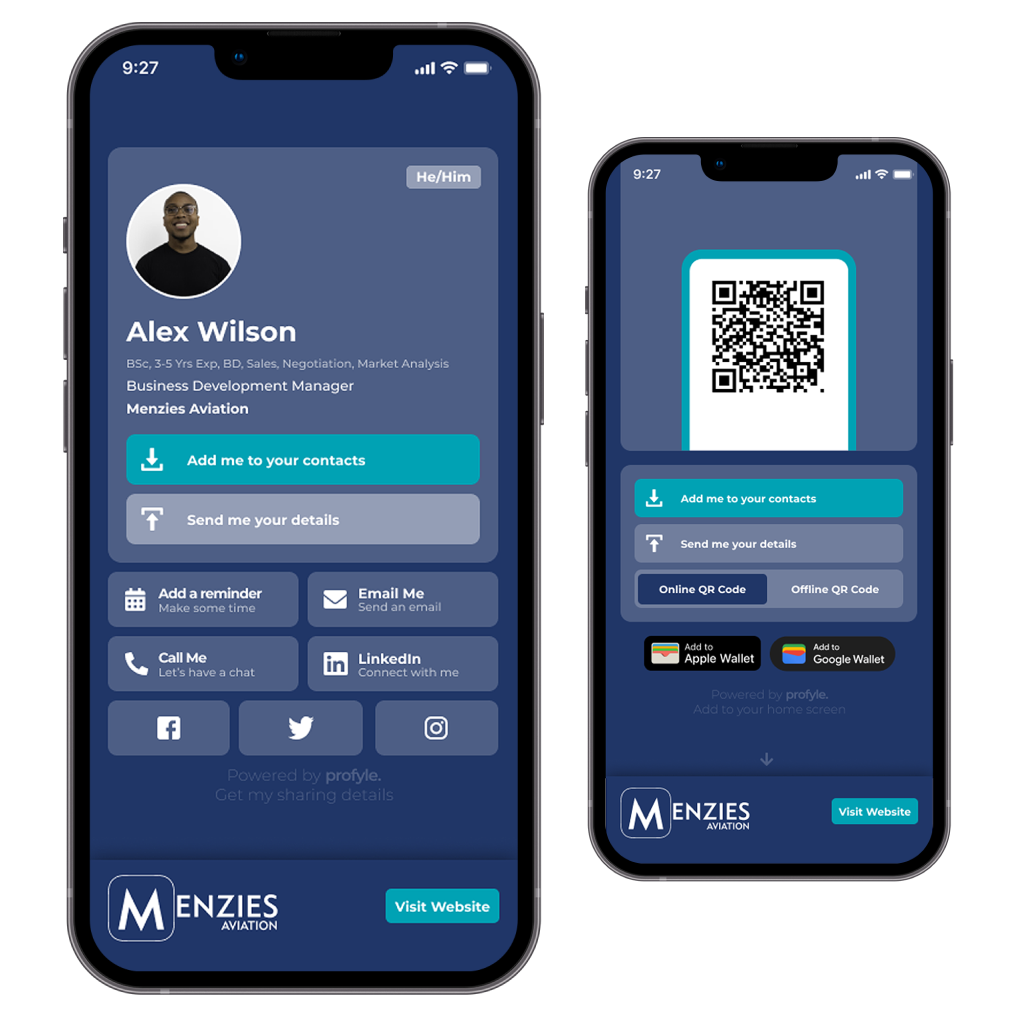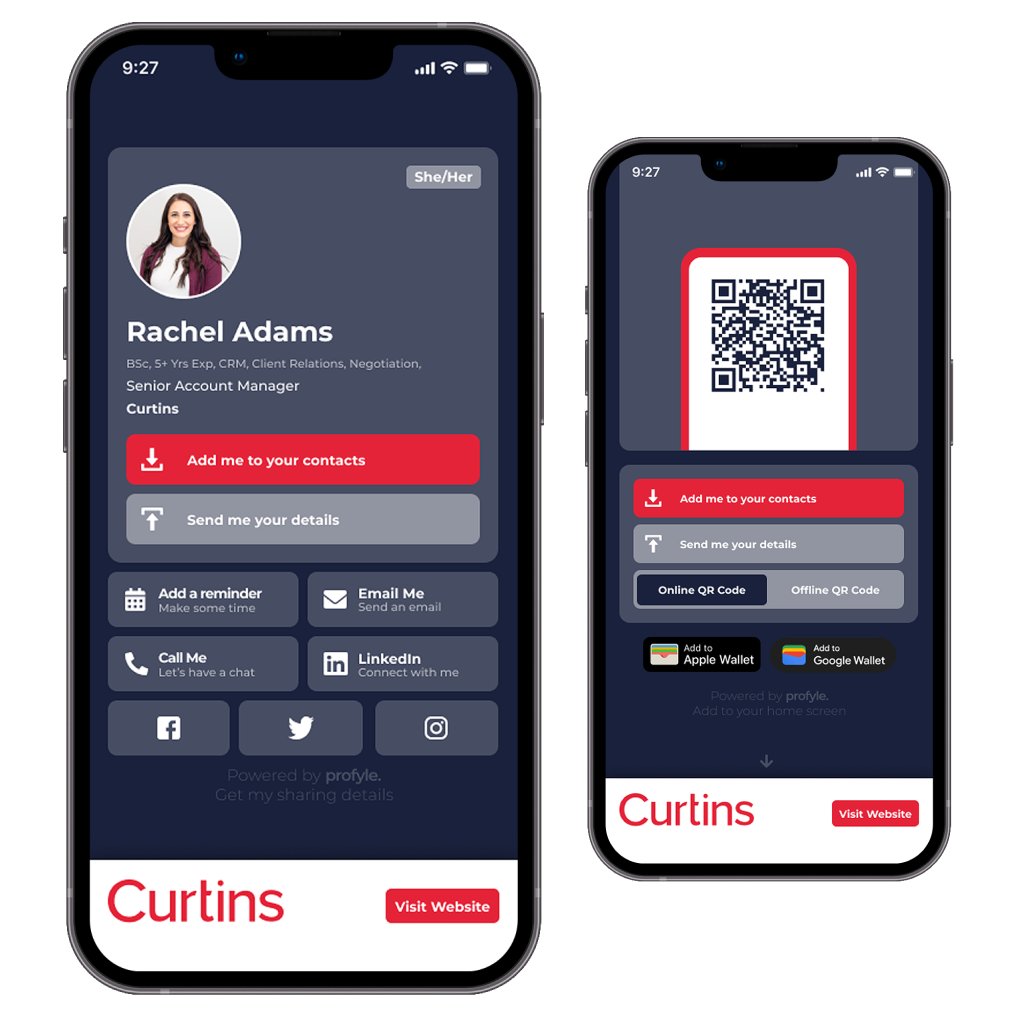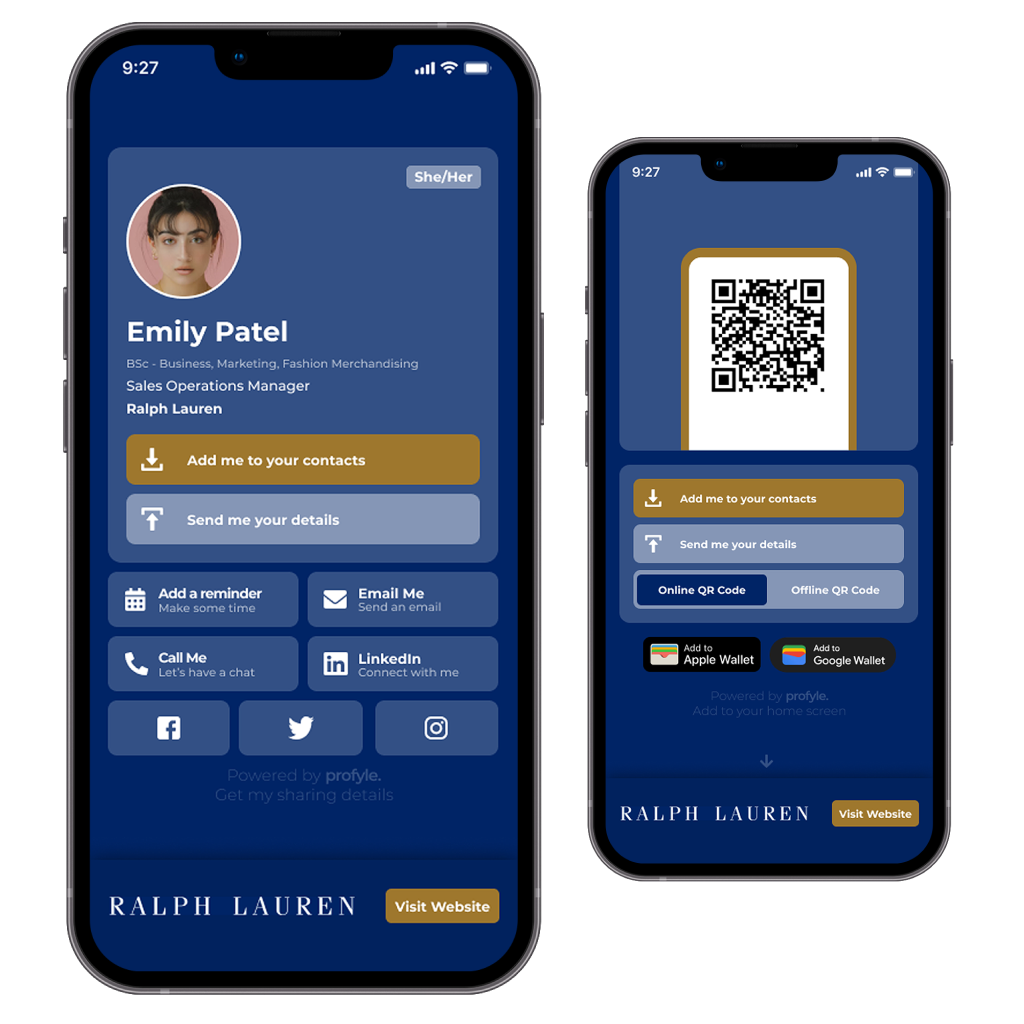
Your digital business card shows more than your contact details. It’s a reflection of your brand. To make a stronger first impression, match your card’s design with your brand. Here’s how:
Brand Identity Basics: Use your logo, colors, fonts, and messaging style. They show your company’s personality and values.
Key Design Elements:
Place your logo prominently.
Match fonts to your brand’s tone (e.g., serif for traditional, sans-serif for modern).
Use your brand’s colour scheme thoughtfully for recognition and readability.
Practical Steps:
Check your brand assets.
Make sure they are consistent across all platforms.
Test your designs on different devices.
UK Digital Business Card Tips:
Use British English.
Follow local formatting: +44 for phone numbers and DD/MM/YYYY for dates.
Embrace simple, professional designs.

Digital business cards are a eco-friendly, interactive alternative to paper ones. Because of that, just by showing one you help build a strong, consistent brand image. Platforms like Profyle Card make this process easier. They offer tools for customization, consistency, and eco-friendly solutions.
Here is Why Digital Business Cards Matter:
They’re eco-friendly.
They’re interactive.
They also help keep consistency across platforms and support modern networking needs.
To make a digital business card that highlights your brand, focus on these main design elements. These elements should work together. Because they help keep your brand’s look the same across all platforms. This way, you reinforce your identity with every interaction.

Your company logo is key to your brand’s visual identity. Its placement on your digital business card matters a lot. Display the logo clearly and follow your brand guidelines. Common placements are the top left, top right, or center, based on the layout. For vertical designs, consider using a larger logo in either the top or bottom half of the card. Your logo should either be bold and prominent or subtle and understated. This choice reflects your brand’s personality. Pair the logo with typefaces that align with your brand’s tone to ensure consistency.

Fonts do more than display words, they communicate your brand’s essence. Think about your brand’s character. Choose typefaces that match its tone. Serif fonts give a traditional and professional vibe. In contrast, sans-serif fonts feel modern and clean. Check your selected fonts on different devices. This way, you can be sure they stay clear and easy to read for everyone. After your typography matches your brand, choose a color palette to enhance it.

Colour plays a significant role in shaping perceptions of your brand, so using your brand’s colour scheme thoughtfully is key. Your main brand colour should be prominent. Use it for the background or in key design elements. This helps people see your business card and link it to your other marketing materials. Use secondary or accent colours to highlight important details and add interest. Make sure there’s good contrast for easy reading. Pick colors that reflect your brand’s emotions and values.

Create digital cards that show your brand identity. Follow these steps for a consistent, polished look.
Before diving into the design process, take stock of your brand assets. Collect high-quality digital items. This includes your logo in formats like PNG, SVG, and EPS. Also, gather a precise color palette with hex codes and approved fonts. Think about using a cloud-based Digital Asset Management system. It can help you store and organize these resources. This makes it easier to collaborate. It also keeps your assets safe and easy to access when you need them. Putting all your assets together lets you make digital cards that match your brand’s look.
Your digital business card should match your other branded materials. This creates a consistent and recognizable experience. Create brand guidelines that detail logo placement, color use, typography, and imagery styles. Remember to include tone and messaging standards. This helps keep communication consistent. Regularly review digital platforms to identify and fix any inconsistencies. A strong brand presence at every touchpoint looks professional. It also builds trust with your audience.
Once your design is ready, it’s crucial to test its functionality across various devices and platforms. Check how your digital card performs on iOS, Android, and different web browsers to spot any compatibility issues. Make the layout responsive by using easy-to-read fonts. Keep good contrast between the text and background. Set a base font size of 16px and use scalable units. Interactive features like clickable links and contact buttons should work flawlessly. Gather feedback from colleagues who use different devices to refine the user experience. Testing and improving your digital card helps everyone have a smooth and professional experience.

Profyle Card simplifies digital branding. It provides tools to keep your brand consistent and professional. From custom designs to eco-conscious solutions, it covers all aspects of modern branding.
With Profyle Card, you can make a unique and eye-catching alternative to paper cards. The platform lets you print in full color on both sides of NFC cards. This way, your brand colors shine through perfectly. Upload logos, set brand colors, and choose typography that matches your style guidelines. Whether you follow their design templates or opt for direct design support, the process is simple. Plus, the design library makes it easy to manage and update brand assets whenever needed.
The Admin Portal is your main hub for managing users, cards, and brand assets. It helps keep a consistent look across your organization. Create custom Profyle Pages! You can design branded landing pages. Choose from modern themes and customize button styles, colors, backgrounds, and logos. Create unlimited layouts so every employee’s card reflects your brand identity. The group feature helps you adjust designs for different roles or departments. This way, you keep a consistent look. This level of control ensures a polished and professional impression every time.
Profyle Card goes beyond branding by prioritising environmental responsibility. The cards are reusable and updatable, significantly cutting down on single-use waste. As part of its commitment to sustainability, Profyle Card is Carbon Neutral certified by Carbon Neutral Britain. Even the packaging is eco-friendly, made from recyclable or recycled materials.
When a card reaches the end of its life, a recycling programme is in place, offering credit for returned cards. This commitment to sustainability matches UK businesses’ priorities. Here, environmental awareness often affects buying choices.
“We wanted a custom solution that was reusable and would save us costs on printing and design individual paper cards for our team.” – Sam Hyams, Founder & CEO at Springpod

To create digital business cards for the UK market, you need to understand local norms and professional expectations. Aligning with these standards helps your cards connect with British professionals. It also boosts your credibility.
Using British English isn’t just about adding a “u” to words like “colour.” It shows precision and an understanding of local professional norms. Using proper UK spelling shows attention to detail and cultural awareness. These traits are highly valued in British business.
“Using prioritised UK spelling in international contexts promotes standardisation, reducing confusion and improving clarity, particularly in professional and diplomatic settings.” – Dr. Emily Dawson, linguistics expert at the University of Oxford.
Big British brands like Burberry, Jaguar, and British Airways use UK spelling. This helps them show their national identity worldwide. Your digital business cards should match this standard. Use “organisation” instead of “organization,” for example.
You can simplify this process by using tools like Microsoft Office and Google Docs. They let you set UK English as the default language. This helps ensure correct spelling and grammar.
Formatting plays a vital role in maintaining professionalism. In the UK, dates are written in the day-month-year (DMY) format, so your card should display dates as 31/12/1999, not in the American month-day-year style.
Pay close attention to phone numbers as well. UK telephone numbers can be up to 15 digits long and should include the international country code +44 when displayed globally. For instance, a London-based number would appear as +44 20 7123 4567.
When referring to monetary values, always place the pound symbol (£) before the amount. As for time, both the 24-hour format (e.g., 23:59) and the 12-hour format (e.g., 11:59 p.m.) are acceptable, depending on your industry norms.
Following these conventions shows you know British business practices. This can create a strong, positive impression.
Your digital business card should reflect the simple and elegant style of British business culture. This includes attention to spelling and formatting. Loud or overly elaborate designs may feel out of place. Instead, focus on clean, modern layouts that balance professionalism with approachability. This subtle elegance conveys reliability and expertise, aligning with UK business values.
Sustainability is another growing priority in the UK. Many professionals like eco-friendly options. Digital business cards show your commitment to the environment. A fintech startup saw more qualified leads after using interactive smart cards at networking events. A creative agency in Manchester got more client engagement. They added links to their online portfolio and social media on their digital cards.
Highlight your card’s eco-friendly features to connect with UK professionals. Balance innovation with tradition. Your digital business cards should use modern tech and respect British business etiquette.
Digital business cards have become a must-have in today’s networking landscape. They surpass regular paper cards. They offer interactive features and real-time updates. Plus, they show off your brand’s personality and eco-friendly mindset. These cards show your brand well. They highlight your tech skills and care for the environment.
The quality of your business card plays a critical role in shaping perceptions. Research indicates that 72% of people judge a company by its business card quality. Also, 39% might steer clear of a business if the card looks cheap or unprofessional. As Tristan Le Breton, Creative Director at 99designs by Vista, puts it:
“Your card is more than just your contact information; it’s a representation of you and your brand.”
This shows how important it is to make a digital card that really represents your brand. To do this, audit and standardize your visual assets. This will ensure consistency on all digital platforms. Test your digital cards across various devices to guarantee they present well everywhere. Digital cards can also work with CRM systems and social media. This helps manage data better and boosts customer engagement.
With these advantages, a dedicated platform can simplify and optimise your branding efforts.
Profyle Card offers an easy way to design and manage digital business cards that align with your brand. Its customization tools and design features help you keep your branding consistent everywhere. The platform offers options for personalized branding, multi-language support, and easy CRM integration. This makes it a strong tool for centralizing brand management.
Profyle Card offers UK businesses custom branding solutions. These meet local standards and promote sustainability. Reusable and updatable cards help companies cut their environmental impact. They can do this while still looking professional.
To ensure your digital business card shows your brand identity, add key visual elements. Include your logo, brand colors, and typography. These should align with your company’s existing branding to present a consistent and polished image. Place your logo in a prominent spot and stick to fonts and colours that follow your brand guidelines.
Picking a platform with customizable design options helps keep your team consistent. Some tools let you lock branding elements. This keeps your logo, colors, and messaging consistent, no matter who makes or uses the card. It’s also a good idea to periodically review and refresh your designs to keep them in sync with any updates to your brand identity.
Digital business cards offer a smart way to cut down on paper waste and the environmental toll of traditional printing. They help reduce deforestation and cut carbon emissions by ditching paper. This makes them a friendlier choice for the planet. Plus, since they’re reusable, there’s no need for constant reprints, which adds to their eco-conscious appeal.
From a practical standpoint, digital cards are incredibly convenient. They’re simple to update and share, ensuring your contact details and branding stay fresh. You can personalise them with your company’s logo, colours, and fonts to reflect your brand’s identity. Features like QR codes and NFC technology make sharing your details quick and hassle-free. These cards also include analytics tools. This lets you track how people use your card, which is great for monitoring engagement.
To make a digital business card that appeals to British professionals, follow UK standards and preferences. Start with the standard UK business card dimensions of 85 mm x 55 mm to ensure familiarity. Please use British spelling and keep a polite, professional tone to meet local standards.
Opt for a clean, minimalistic design that reflects the UK’s preference for subtle sophistication. Stick to metric measurements and present contact information in a clear, organised manner. Simplicity in layout is key, making it easy for recipients to navigate the details. Make sure any interactive features, like clickable links or QR codes, follow GDPR rules. This helps protect data privacy. By adhering to these guidelines, your digital business card can leave a polished and professional impression on a UK audience.
Sign up for our free 45-day trial and experience the future of networking today. Embrace efficiency, embrace sustainability, embrace the future with Profyle Card.
Don’t forget to follow us on LinkedIn, Instagram and Twitter
Freelancers & Contractors
Small Teams & Start-Ups
Small & Medium Business
Enterprise Business
vs V1ce
vs Tapitag
vs Blinq
vs Linq
vs Mobilo
vs Tapni
vs Popl
vs Doorway
vs LinkedIn
vs Moo.com
vs Printed.com
Business Size
Freelancers & Contractors
Small Teams & Start-Ups
Small & Medium Business
Enterprise Business Coming Soon
Partnerships
Become an Agency Partner
Profyle Affiliate Programme
Our Partners New
Comparison
vs V1ce
vs Tapitag
vs Blinq
vs Linq
vs Mobilo
vs Tapni
vs Popl
vs Doorway
vs LinkedIn Coming Soon
vs Moo.com Coming Soon
vs Printed.com Coming Soon
Copyright © 2025 Profyle Card Ltd. “Profyle” and the Profyle Card logo are registered trademarks of this company.
Registered in England and Wales with Company Number 12973729. VAT Registration Number: GB424998061
We estimate average savings as a percentage of a typical customer’s total spend on printed and digital business cards when using Profyle features designed to reduce those costs. This percentage is illustrative and should not be considered a guarantee, as actual savings will vary by user. Importantly, Profyle helps reduce more than just card printing expenses. Our calculations may also factor in savings from non-printing-related areas—for example, time saved on manual CRM updates or the financial benefit of replacing alternative solutions. These estimates are based on a combination of platform usage data, industry research, customer feedback, and competitor comparisons. For more details, please refer to our Terms of Service.
Business Address: Unit 118, 23 Paynes Wharf, London, SE8 3GG, United Kingdom. All other trademarks and service marks belong to their respective owners.